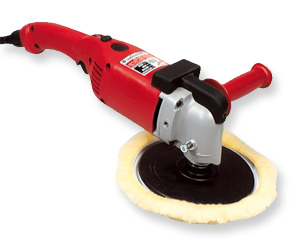Thanks Fantasma...love the enthusiasm.
Buffing:
This is the most complex part of auto care, period. To give it it's due attention, this will probably require multiple posts over the next few days, so please bear with me. Machine buffing can make a dramatic difference in your paint's appearance, both good and bad. If this is your first time handling a buffer, I strongly suggest you attempt glazing first which I'll cover as we go along here. So let's get started with equipment first.
Tools you will need:
First off you will need a buffer, so let's talk about brands and features. The buffer you want to use is a variable speed model like the Makita shown below with a white foam pad attached. This is a glazing pad, more on that later...

Makita makes a good buffer. It's relatively light-weight, so it's easier to handle than say a Milwaukee, shown here wearing a white wool pad. This is a cutting pad.

What's the difference? Price for one. The Makita can be picked up for around $200 USD, while the Milwaukee will run $300+. Weight is also a factor. The Makita comes in at about 6.5 pounds, while the Milwaukee tips the scales at a hefty 9 pounds. This may not sound like a lot, but believe me it will beat your ass over the course of a day. Now don't get me wrong, I own a Milwaukee myself...it's the buffer I learned on many years ago, and it's a tough machine to beat. It's an extremely reliable bullet-proof piece of equipment, and the extra weight is a plus when you have to do heavy compounding jobs. The Makita motor produces about 10 amps, while the Milwaukee runs a wrist snapping 12 amp motor.
The Milwaukee is probably the most common machine among professionals, but you're not likely to see one in the detail shop at your local auto dealer. There's a couple of reasons for this...first, I said it was common among professionals, not the lot porters you find spinning pads at a dealership. Most importantly, it's a theft issue. High-end Milwaukee buffers have the best resale value in their class, so a lot of them found their way into pawn shops. (Good place to buy one) For this reason, you'll find lower end equipment in dealer's shops. Here's a good example made by Chicago tools:

This machine retails for about $30-40 USD, so you can see why dealers buy them for their shops. It claims a 10 amp motor, but it's no Makita. It does feature variable speed, but it takes a while to spool up to 3000 rpm...trust me, I have one. Why? It's a good lower speed buffer for glazing at 1800 rpm.
If you're a first time buffer, buy the Chicago. If you'll only buff one car in your life, buy the Chicago. If you're looking for a glazing machine to keep on hand so you don't have to keep swapping out heads and pads, buy the Chicago. It won't break your budget...at this price, you can afford to keep it on the shelf for 10 years. It's got enough power to buff a car, but not enough to get you into trouble like the Milwaukee.
Oh, and before I forget....

For purposes of this discussion, this IS NOT a buffer. This is a plastic child's toy, and you can do a better job by hand. Don't waste your money.